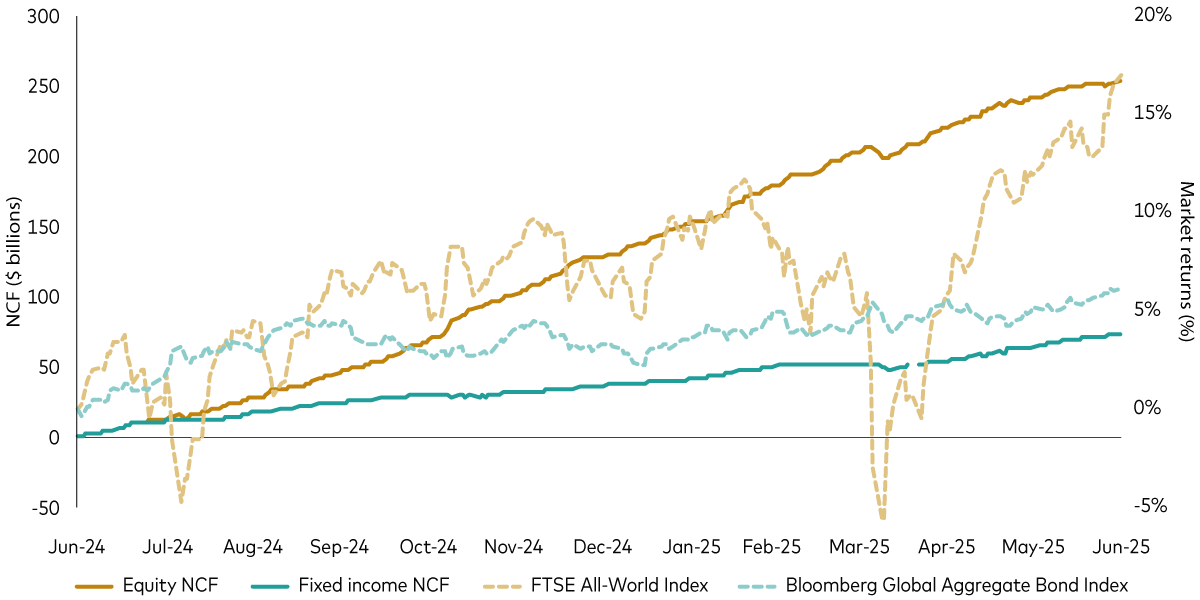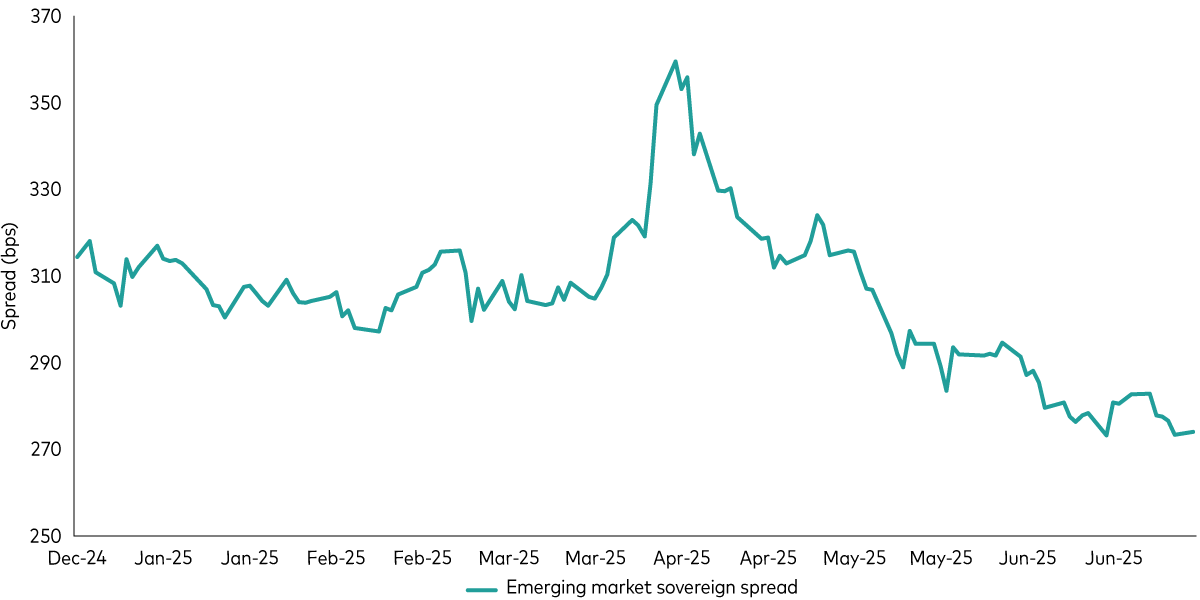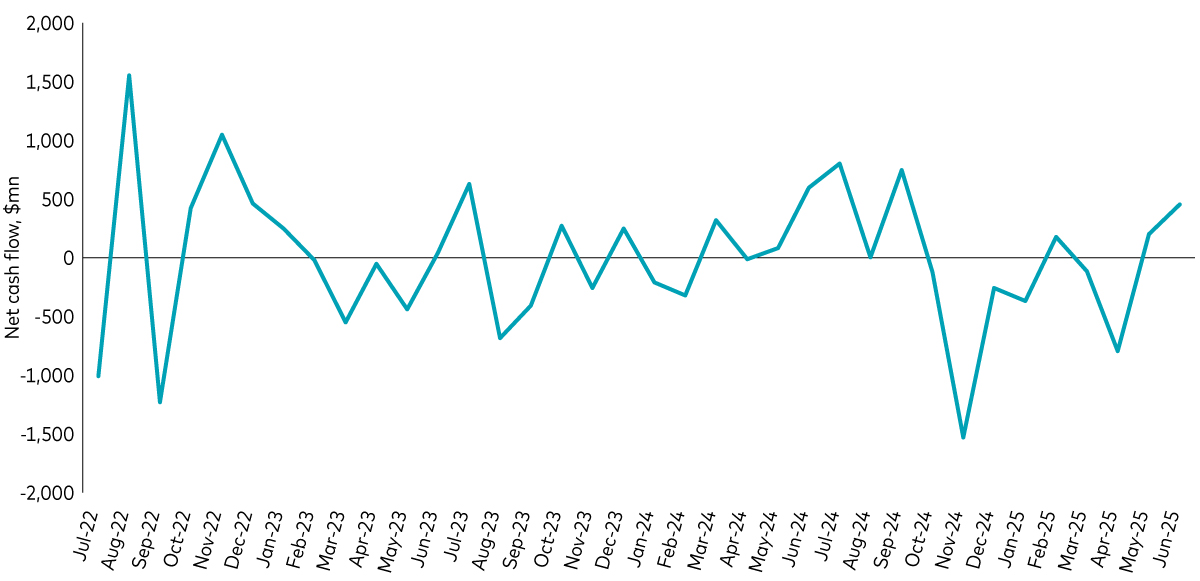Key takeaways
ETF industry overview: Europe-domiciled ETFs saw inflows in Q2 2025. Investors continued exploring equity exposures outside the US, such as developed markets and Europe, while thematics and ultra-short-maturity bond ETFs also saw inflows.
Equity spotlight: As investors look to diversify beyond US equities, emerging market ETFs offer a way to gain exposure to real economic activity while reducing concentration risk.
Fixed income spotlight: Emerging market hard-currency sovereign bonds can be an effective diversifier in portfolios due to their combination of duration and spreads, while also offering an attractive starting yield.
Capital markets spotlight: When considering a trade, investors often look only at average daily volume (ADV) to assess ETF liquidity. To ensure they fully understand an ETF’s liquidity profile, investors should also look at three other key measures.
ETF industry: Q2 at a glance
Europe-domiciled ETFs enjoyed another quarter of net inflows, collecting $71.1 billion in Q2. Beneath the surface, however, we saw notable shifts in flow patterns. While developed market and Europe ETF exposures continued their sustained net inflows—with $13.3 billion and $31.8 billion in Q2, respectively—US and China regional ETFs saw the largest deceleration in flows compared with Q1 2025.
Core beta ETFs continued to see the bulk of equity ETF inflows. When looking at equity sub-classes, we saw inflows into thematic products outpace other categories. The interest in thematic ETFs, which was driven mainly by defence ETFs in Q2, marks a departure from 2024 when thematics were largely out of favour.
Fixed income ETF investors have continued to allocate to short- and ultra-short-maturity products, taking advantage of attractive yields. For context, the ultra-short category drew in $7.0 billion in net cash flow (NCF) in Q2, nearly matching Q1 flows. Global government bonds were the second most-popular allocation for investors, who utilised the exposure as a shock absorber amid uncertainty, blending downside protection with diversification across multiple countries.
ETF industry NCF relative to market returns by asset class

Past performance is not a reliable indicator of future returns.
Source: ETFbook, Bloomberg and Vanguard. Data from 1 July 2024 to 30 June 2025. Performance calculated in USD with gross income reinvested.
Equity spotlight
Adding emerging market equities for diversification
Finding opportunities outside the US equity market remains on the minds of investors. In this context, we have seen emerging market (EM) equities stepping out of the shadow of developed markets. The growing interest suggests investors are looking to capture an early-stage opportunity through the lens of regional diversification.
Despite the market volatility caused by tariff announcements in April, we saw inflows into EM equity exposures of $4.6 billion in Q2 – an increase of 38% compared with Q1.
Key to the case for EM equities is the repricing opportunity they offer. With US equities undergoing a re-rating and valuation compression, EM stands out as a region where earnings growth is being repriced more fairly. Moreover, through EM equities, investors can gain exposure to real economic activity beyond tech-dominant mega-caps while reducing concentration risk.
Although EM equities can be more volatile than developed market peers, they offer meaningful diversification benefits. EMs often have different economic cycles and drivers compared with developed economies, which can help smooth out portfolio performance. In considering the outlook for EM, the growth-inflation dynamics across countries such as China, Brazil and India will figure prominently.
Fixed income spotlight
Investors also see the case for EM bonds
One winner from the Q2 risk rally was EM bonds. EM hard currency sovereign spreads tightened around 27bps in Q2, after remaining relatively rangebound in the first quarter, as the chart below illustrates.
Despite April volatility, EM spreads tightened in Q2

Source: JPM EMBI Global Diversified Sovereign Spread. Data from 31 December 2024 to 30 June 2025.
EM hard-currency sovereign bonds can be an effective diversifier in portfolios due to their combination of attractive duration and spreads. During a risk-on market environment, when we generally see strong investor demand for credit, spreads tend to tighten and thus EM sovereign bonds benefit from the spread move. EM debt can also benefit from the higher duration it offers versus other fixed income sub-asset classes if yields go lower. In addition, EM bonds can offer an attractive starting yield1, providing strong carry in case of future volatility in either spreads or duration.
Even within EM, hard-currency sovereigns have outperformed corporates. Furthermore, sovereign and quasi-sovereign EM exposure could offer improved downside mitigation than EM corporate exposure in periods of market stress, particularly if trade tensions put pressure on corporate margins. And from a valuation perspective, EM sovereigns also appear more attractive relative to EM corporates.
The April tariff shock meant that the second quarter started off turbulent for EM bonds. However, spreads received some relief from the negotiations that took place in the ensuing months. A weaker dollar, meanwhile, provided a tailwind for EM sovereigns, making their dollar-denominated debt payments more affordable.
Certain positive developments also drove EM bond performance. For example, Argentina successfully lifted capital controls limiting Argentinians’ purchase of US dollars, leading to a rally in Argentina’s sovereign bonds.
Overall positive performance led to a return of flows into EM bond ETFs in Q2, which has also provided a supportive technical backdrop for returns.
Flows into EM bond ETFs rebound in Q2

Source: Morningstar, as at 30 June 2025. Flows peer groups: global emerging market bond, global emerging market bond – GBP hedged, global emerging market bond – EUR hedged, global emerging markets bond – CHF hedged.
Capital markets spotlight
What are the measures of ETF liquidity?
When considering a trade, investors often mistakenly look only to average daily volume (ADV) to assess ETF liquidity. To ensure they fully understand an ETF’s full liquidity profile, investors should instead focus on the following key measures, in our view:
ETF bid-ask spread: The average cost to trade ETFs is represented by their quoted spread on the secondary market. This metric can be viewed as the price for liquidity in the secondary market.
ETF market depth: The number of shares available to trade at or near the quoted spread. Unlike ADV, this metric provides a better glimpse into the current inventory that market makers have available at the quoted price.
Basket spread: The cost to acquire underlying holdings, which is often indirectly passed through to clients. When your trade is large enough to require creating new shares or redeeming them in the primary market, the basket spread may be a better indication of the cost to trade an ETF.
Basket liquidity: The liquidity of the underlying securities within an ETFs basket, including their volumes and spreads. Again, relatively liquid securities like large-cap equities or US Treasuries can be expected to have tighter spreads than, say, small-cap equities or emerging market bonds.
With all these variables to consider, which metric is the right one to reference? The factors to prioritise depend on two aspects: the size of the trade and the liquidity of a particular ETF’s underlying securities.
The ADV, while important, is in the middle of the pack of considerations in each of these scenarios. That’s because ADV serves to identify which cost factor to focus on. Generally, for a smaller sized trade it would be prudent to assess the fund’s spread, whereas for a larger sized trade, the fund’s basket spread will be of higher importance.
Liquidity considerations in smaller and larger trades

Source: Vanguard. The above diagram is for illustrative purposes only.
1 Source: Bloomberg, as at 30 June 2025. Yield is yield to worst, USD hedged. For example, the Bloomberg EM USD Sovereign + Quasi-Sovereign Index offers a 6.3% starting yield.
Related ETFs
Important risk information
The value of investments, and the income from them, may fall or rise and investors may get back less than they invested.
Performance figures shown may be calculated in a currency that differs from the currency of the share class that you are invested in. As a result, returns may decrease or increase due to currency fluctuations.
Investments in smaller companies may be more volatile than investments in well-established blue chip companies.
ETF shares can be bought or sold only through a broker. Investing in ETFs entails stockbroker commission and a bid- offer spread which should be considered fully before investing.
Funds investing in fixed interest securities carry the risk of default on repayment and erosion of the capital value of your investment and the level of income may fluctuate. Movements in interest rates are likely to affect the capital value of fixed interest securities. Corporate bonds may provide higher yields but as such may carry greater credit risk increasing the risk of default on repayment and erosion of the capital value of your investment. The level of income may fluctuate and movements in interest rates are likely to affect the capital value of bonds.
The Funds may use derivatives in order to reduce risk or cost and/or generate extra income or growth. The use of derivatives could increase or reduce exposure to underlying assets and result in greater fluctuations of the Fund's net asset value. A derivative is a financial contract whose value is based on the value of a financial asset (such as a share, bond, or currency) or a market index.
Some funds invest in securities which are denominated in different currencies. Movements in currency exchange rates can affect the return of investments.
For further information on risks please see the “Risk Factors” section of the prospectus on our website.
Important information
This is a marketing communication.
For professional investors only (as defined under the MiFID II Directive) investing for their own account (including management companies (fund of funds) and professional clients investing on behalf of their discretionary clients). In Switzerland for professional investors only. Not to be distributed to the public.
The information contained in this document is not to be regarded as an offer to buy or sell or the solicitation of any offer to buy or sell securities in any jurisdiction where such an offer or solicitation is against the law, or to anyone to whom it is unlawful to make such an offer or solicitation, or if the person making the offer or solicitation is not qualified to do so. The information in this document does not constitute legal, tax, or investment advice. You must not, therefore, rely on the content of this document when making any investment decisions.
The information contained in this document is for educational purposes only and is not a recommendation or solicitation to buy or sell investments.
Issued in EEA by Vanguard Group (Ireland) Limited which is regulated in Ireland by the Central Bank of Ireland.
Issued in Switzerland by Vanguard Investments Switzerland GmbH.
Issued by Vanguard Asset Management, Limited which is authorised and regulated in the UK by the Financial Conduct Authority.
© 2025 Vanguard Group (Ireland) Limited. All rights reserved.
© 2025 Vanguard Investments Switzerland GmbH. All rights reserved.
© 2025 Vanguard Asset Management, Limited. All rights reserved.
